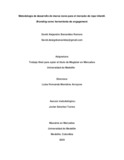Metodología de desarrollo de marca ícono para el mercado de ropa infantil : branding como herramienta de engagement
Compartir este ítem
Fecha
2020-07-12Autor
Benavides Romero, David Alejandro
Citación
Metadatos
Mostrar el registro completo del ítemDocumentos PDF
Resumen
Dentro de las temáticas planteadas por el Grupo Tetrix se decide trabajar en la línea de investigación de macromarketing, con un enfoque específico en Branding; Esto debido a varios motivos, el primero de ellos y más importante, el gusto y la empatía con el tema, los años de experiencia trabajando en temas de posicionamiento, creación de marca y su gestión en general (Macrae, 1998) han llevado a despertar un interés por aquellas compañías que generan una cultura que va más allá del producto o servicio que ofrecen, su identidad poderosa y cómo desde su congruencia crean ventajas competitivas en un mercado cada día más exigente (de Chernatony, 1999). Muchas organizaciones le apuestan a la figura de gerencia de marca, con el fin de crear marcas poderosas sin embargo, muchas de ellas se quedan en generalidades enfocadas a campañas con fecha de caducidad (Hoeffler & Keller, 2002). David Aaker, afirma que una marca debe reunir varios elementos para llegar a ser fuerte, entre ellos la recordación, la familiaridad, la notoriedad y los niveles de diferenciación en la mente de los consumidores principalmente (D. A. Aaker, 1996a). Hay algunas que van más allá y logran crear estilos de vida e impactar tanto culturalmente, que traspasan el escenario de consumo, incluso, durante generaciones (Ries & Trout, 2001). Es allí donde se encuentra la oportunidad de investigación, a partir de un estudio profundo de las variables que rodean una marca como ícono cultural y los principales modelos de construcción de marcas ícono aplicados a estas, llevándolos al mercado de ropa infantil como apoyo a las compañías emergentes y a aquellas que llevan un recorrido en la búsqueda del fortalecimiento de su marca al nivel de crear comunidades y perfilarse como íconos (KOTLER, 2008). Many organizations bet on the figure of brand management, in order to create powerful brands, however, many of them remain in generalities focused on campaigns with expiration dates (Hoeffler & Keller, 2002). David Aaker states that a brand must gather several elements to become strong, among them the remembrance, familiarity, notoriety and levels of differentiation in the minds of consumers mainly (Aaker, 1996). There are some that go further and manage to create lifestyles and impact culturally so much that they transcend the consumption scenario, even for generations (Ries & Ries, 2001). It is there where the research opportunity is found, from an in-depth study of the variables that surround a brand as a cultural icon and the main models of construction of icon brands applied to these, taking them to the children's clothing market in support of emerging companies and They can take a journey in the search for the reinforcement of their brand to the level of creating communities and profiling as icons (KOTLER, 2008). The study methodology was based on in-depth interviews. With the analysis of 3 real cases in the city of Medellín, in which impact brands have been created and managed (even considered icons in the city), it was intended to have a starting point in relation to the variables that surround those brands considered icons. The case study analyzed the forms of brand creation that are implemented in the local market and the scope they have had. It was found that those brands that emotionally connected with their consumers from an idealized story, positioned themselves easier than their competitors.
Colecciones
- Tesis [725]


